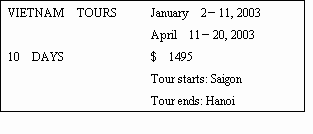题目内容
________ you ________ the cute koala bear in the zoo last Monday?
- A.Do; see
- B.Do; look
- C.Did; see
- D.Did; look

Do you speak English? Do you speak e-mail English? Maybe you don’t. E-mail English is a new kind of English that many people use to save time. A lot of e-mail English words come from a computer program called QQ, which means I seek(寻找)you. Ian Lancashire, a Canadian teacher, likes QQ, “People can use QQ to talk with each other using computer. But, you have to be able to type quickly or the other person will be bored. So e-mail English can give some help.”
A message in e-mail English mostly uses two kinds of new words. The first kind is made up of the first letters of the words. These are called acronyms. The second kind is homophones,letter combination(合并), symbols that sound like other words.
Acronyms in an e-mail save space and time. It takes a long time to write by the way. BTW is much faster. Other acronyms are F2F which stands for face to face, CSL for can’t stop laughing and DBEYR for don’t believe everything you read! Some of the acronyms look like strange words, such as SWAK. But this one means sealed(封口) with a kiss.
Homophones often use letters and numbers that sound like words or parts of words. For example, 8 sound like—eat in great, to save time, people write gr8. Another example is CU for see you or sometimes CU l8r (see you later)
The number 2 is used for to or too and the number 4 is used instead of for.
Another part of e-mail is emotive symbols(表情符号) which make faces when you look at them sideways. The most common emotive, is the happy face :). A comma (逗号) is often used to help add other parts of the face and show different expressions.
E-mail English is fun. An e-mail message with lots of e-mail English starts to look like secret code(密码). Your best friend will probably understand it, but your parents and teachers may not. In fact, many teachers don’t like e-mail English. It’s not just because they can’t comprehend what it means. It’s because students start to use e-mail English in their everyday writing. E-mail English is great for writing quickly. But most teachers say that e-mail English should only be used in e-mails to one’s friends.
【小题1】What does the writer talk about in the first paragraph?
| A.How to read new e-mail words. |
| B.How new e-mail words are made. |
| C.Why people use e-mail English. |
| D.Canadian teachers and their e-mails. |
| A.accept | B.understand | C.guess | D.prefer |
| A.Parents will have to learn some e-mail English. |
| B.E-mail English will develop our everyday writing. |
| C.E-mail English can’t be used among schoolmates. |
| D.E-mail English shouldn’t be used in school writing. |
| A.E-mail English on Computer. | B.American E-mail English. |
| C.The Forms of E-mail English. | D.The Changing of English. |

 visit the serene and beautiful mausoleums of the old kings of Vietnam.
visit the serene and beautiful mausoleums of the old kings of Vietnam. Do you know what use a mobile phone has? Yes, you can use it to do a lot of things.
Do you know what use a mobile phone has? Yes, you can use it to do a lot of things.